Attached files
| file | filename |
|---|---|
| 8-K - FORM 8-K - EXELON GENERATION CO LLC | d8k.htm |
 Exelon Nuclear Update
March 24, 2011
Exhibit 99.1 |
  2
Forward-Looking Statements
This presentation includes forward-looking statements within the meaning of
the Private Securities Litigation Reform Act of 1995, that are subject to
risks and uncertainties. The factors that could cause actual results to
differ materially from these forward-looking statements include those
discussed herein as well as those discussed in (1) Exelon’s 2010 Annual
Report on Form 10-K in (a) ITEM 1A. Risk Factors, (b) ITEM 7.
Management’s Discussion and Analysis of Financial Condition and Results
of Operations and (c) ITEM 8. Financial Statements and Supplementary Data:
Note 18; and (2) other factors discussed in filings with the Securities and
Exchange Commission (SEC) by
Exelon Corporation and Exelon Generation Company, LLC (Companies).
Readers are cautioned not to place undue reliance on these forward-looking
statements, which apply only as of the date of this presentation. None of
the Companies undertakes any obligation to publicly release any revision to
its forward-looking statements to reflect events or circumstances after
the date of this presentation. |
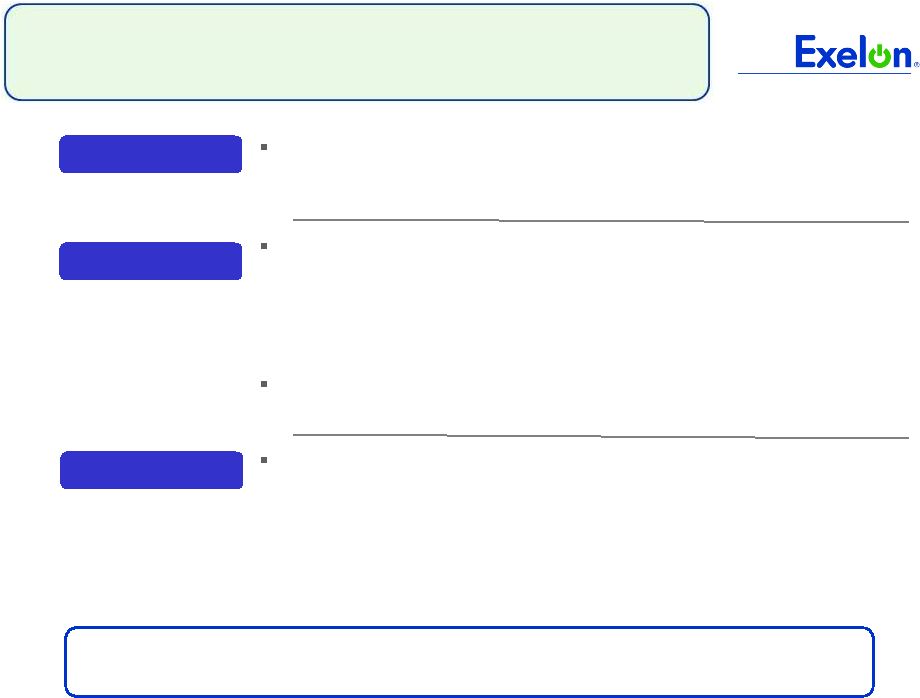  3
Administration
and
regulators
remain
supportive
of
US
nuclear
plants
“Our nuclear plants have undergone exhaustive study and have been
declared safe for any number of contingencies.”
–
President Obama,
March 17, 2011
“The
NRC
remains
attentive
to
any
information
that
can
be
applied
to
U.S.
reactors.
Our
focus
is
always
on
keeping
plants
in
this
country
safe
and
secure. As this immediate crisis in Japan comes to an end, we will look at
whatever
information
we
can
gain
from
the
event
and
see
if
there
are
changes we need to make to our own system.”
–
Chairman Greg Jaczko,
March 16, 2011
“Operating nuclear plants in the United States remain safe, with no need
for immediate action.”
–
NRC, March 17, 2011
“The American people should have full confidence that the United States
has rigorous safety regulations in place to ensure that our nuclear power
is generated safely and responsibly…safety remains at the forefront of
our effort to responsibly develop America’s energy resources, and we
will continue to incorporate best practices and lessons learned into that
process.”
–
Secretary Steven Chu, March 17, 2011
Nuclear plant operations and safety will be evaluated to incorporate lessons
learned, but there has not been a rush to judgment
DOE
NRC
White House |
  4
Japan’s Nuclear Power Plants
Fukushima Daiichi Nuclear Power Station
began operations at Unit 1 in March 1971
4,696 MWe output across 6 BWR
units
All units responded as expected to the
earthquake
Tsunami caused loss of all back-up
power, which is used to cool reactor core
and spent fuel pools
Units 4,5,6 were in cold shutdown for
planned refueling at time of earthquake
and tsunami
Seawater/boron injection into reactor
vessels at Units 1, 2 and 3 continues and
those reactors are now stable
Offsite power restored at all units,
equipment being tested
Source: NEI |
  5
Exelon’s Plants are Designed to Withstand
Extreme Environmental Hazards
None of Exelon’s plants are in major earthquake zones
Designed
to
withstand
highest
level
of
seismic
activity
for
that
location,
with
additional margin
Regular seismic analyses performed by NRC
Emergency core cooling systems are protected from water incursion,
including water tight doors, elevation of equipment above potential flood
levels and/or special engineered flood barriers (on a site-specific
basis) Fuel tanks are buried underground or enclosed in buildings
Switchgear for emergency operations are elevated above flood levels
All but one of Exelon’s plants are in Illinois and Pennsylvania
Oyster
Creek
(in
NJ)
is
more
than
5
miles
inland,
behind
barrier
islands
•
Tsunamis are extremely rare in the mid-Atlantic
•
Oyster Creek is 23 feet above sea level, while the maximum recorded
high tide on the Barnegat Bay beachfront 5 miles away is 7 feet above
sea level
The NRC requires all nuclear plants in the US to be able to withstand the most
severe natural phenomena historically reported for each plant’s surrounding
area, with a significant margin of error
Tsunami
Flood
Earthquake |
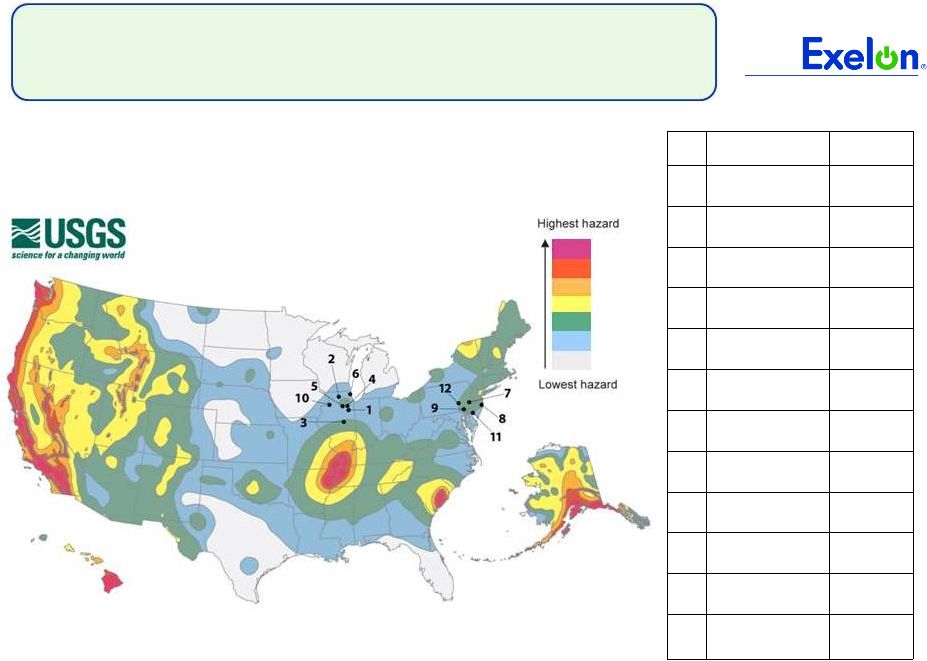  6
Exelon’s Nuclear Plants Are Not In Major
Earthquake Zones
Exelon Plant
G Rating
1
Braidwood
0.20g
2
Byron
0.20g
3
Clinton
0.25g
4
Dresden
0.20g
5
LaSalle
0.20g
6
Zion
0.17g
7
Limerick
0.15g
8
Oyster Creek
0.184g
9
Peach Bottom
0.12g
10
Quad Cities
0.24g
11
Salem
0.20g
12
Three Mile
Island
0.12g |
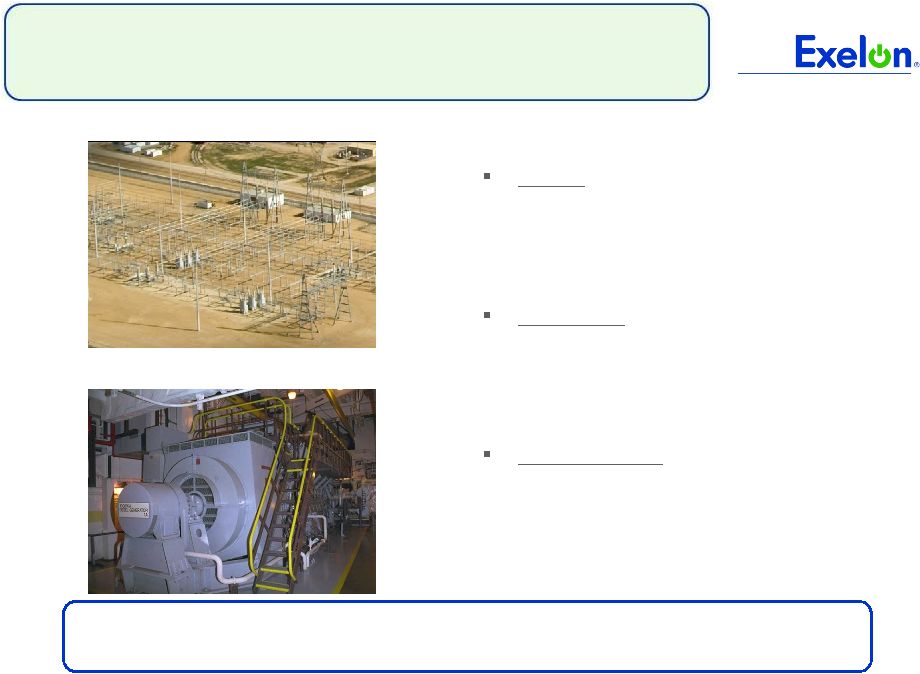  7
7
“Defense
In
Depth”
Design
Ensures
Safe
Operations
Even
in
Station
Blackout
Water:
Exelon’s BWRs have at
least six independent ways to put
water into the core in an
emergency
AC Power:
Exelon’s plants get
electricity from at least two
independent power lines
feeding
two independent transformers
Diesel Backup:
Redundant
systems maintain electric power
when electricity is lost from the grid
off site -
multiple backup diesels at
every site
Exelon’s nuclear plants are able to safely shut down and keep the fuel
cooled -
even without electricity from the grid
Diesel Backup
AC Power |
  8
Emergency Operating Procedures
Emergency Operating Procedures (EOPs) direct operator response to restore or
maintain the water level in the reactor vessel and control containment
temperature and pressure for any emergency condition. Additional
modifications and procedure changes have been implemented in response to a postulated loss of all
offsite and onsite AC power under 10 CFR 50.63, the Station Blackout Rule
Severe Accident Management Guidelines (SAMGs) have been implemented to use
auxiliary equipment and alternate system alignments to provide makeup water
to the reactor vessel or containment. Independent of the EOPs and SAMGs,
additional procedures and alternate equipment is available onsite to provide
water makeup to the reactor vessel and the spent fuel pools should damage occur to the reactor
building.
This equipment consists of pre-staged pumps, piping, and procedures that can
be used independent of onsite AC power sources.
Designated
onsite
and
offsite
emergency
facilities
are
manned
during
an
emergency
to
provide
additional
input
to
the
control
room
operators.
Both
facilities
are
in
direct
contact
with
the
control
room
and
track
use
of
the
EOPs
and
SAMGs.
Beyond the design, equipment and geography of a nuclear plant, other
emergency response protocols ensure safety is maintained in the event of
one or more unexpected severe events |
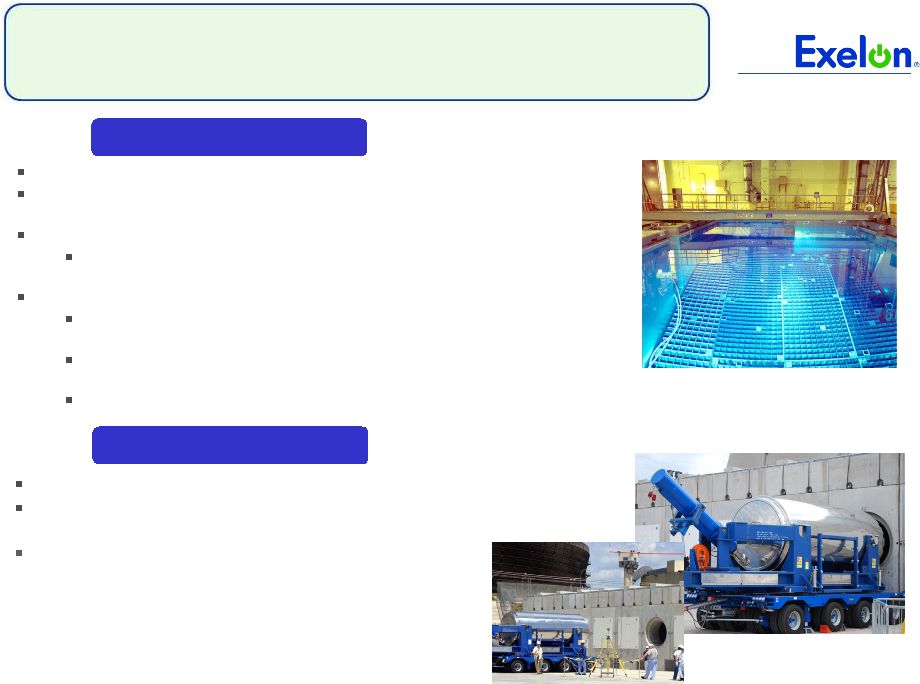  9
9
Spent Fuel Pools and Dry Cask Storage
Main pool cooling system has redundant backup
Additional backup systems can replace water from
other plant water inventories
Multiple onsite water storage tanks with 80,000 to
500,000 gallon capacity and portable, high
capacity pumps available onsite, along with other
sources,
ensure
spent
fuel
pools
remain
filled
in
an
extreme
emergency
–
even
with
significant
water loss
Elevated pools at 6 plants, at or below grade at 5 others
Pool walls are 3-6 feet of concrete with a sealed stainless
steel liner
Fuel remains in pool for a minimum of 5 years
Exelon generally waits 7-15 years before moving to dry
cask storage
Dry cask storage at Exelon plants:
7 in operation (Dresden, Quad, LaSalle, Byron, Peach,
Oyster, Limerick)
3 more on-line before end of 2013 (Braidwood, Clinton,
Zion)
TMI not until next decade
In An Emergency
Steady State
Spent Fuel Pool
Dry Cask Storage |
  10
Nuclear Industry Is Responding Proactively
The World Association of Nuclear Operators (WANO) and INPO have
developed this list of actions to evaluate the readiness and capability of
emergency mitigation systems beyond normal plant design basis
1. Verify capability to mitigate conditions
resulting from beyond design basis events
March 23, 2011
2. Verify capability to mitigate station blackout
conditions required by station design are
functional and valid
March 30, 2011
3. Verify capability to mitigate internal and
external flooding events
April 6, 2011
4. Perform walk-downs and inspections of
important equipment needed to mitigate fire
and flood events and develop strategies to
mitigate any identified vulnerabilities
April 13, 2011
Recommended Action
Due Date
Exelon is fully
responding to each
action item for every
plant in the fleet |
  11
Plant
Location
Type/
Containment
Water Body
License Extension
Status / License
Expiration
(1)
Ownership
Spent Fuel Storage/
Date to lose full
core discharge
capacity
(2)
Braidwood, IL
(Units 1 and 2)
PWR
Concrete/Steel
Lined
Kankakee
River
Expect to file
application in 2013/
2026, 2027
100%
2012
Byron, IL
(Units 1 and 2)
PWR
Concrete/Steel
Lined
Rock River
Expect to file
application in 2013/
2024, 2026
100%
Dry Cask
Clinton, IL
(Unit 1)
BWR
Concrete/Steel
Lined
Clinton Lake
2026
100%
2018
Dresden, IL
(Units 2 and 3)
BWR
Steel Vessel
Kankakee
River
Renewed/2029,
2031
100%
Dry cask
LaSalle, IL
(Units 1 and 2)
BWR
Concrete/Steel
Lined
Illinois River
2022, 2023
100%
Dry Cask
Quad Cities, IL
(Units 1 and 2)
BWR
Steel Vessel
Mississippi
River
Renewed/2032
75% Exelon, 25%
Mid-American
Holdings
Dry cask
(1)
Operating license renewal process takes approximately 4-5 years from
commencement until completion of NRC review. (2)
The date for loss of full core reserve identifies when the on-site storage pool
will no longer have sufficient space to receive a full complement of fuel from the reactor core. Dry cask
storage will be in operation at those sites prior to the closing
of their on-site storage pools.
Exelon
pursues
license
extensions
well
in
advance
of
expiration
to
ensure
adequate
time for
review by the NRC
Exelon Nuclear Fleet Overview -
IL |
  12
Plant, Location
Type,
Containment
Water Body
License
Extension Status /
License
Expiration
(1)
Ownership
Spent Fuel Storage/
Date to lose full
core discharge
capacity
(2)
Limerick, PA
(Units 1 and 2)
BWR
Concrete/Steel
Lined
Schuylkill
River
Expect to file
application in
2011/2024, 2029
100%
Dry cask
Oyster Creek, NJ
(Unit 1)
BWR
Steel Vessel
Barnegat Bay
Renewed/2029
100%
Dry cask
Peach Bottom, PA
(Units 2 and 3)
BWR
Steel Vessel
Susquehanna
River
Renewed/2033,
2034
50% Exelon,
50% PSEG
Dry cask
TMI, PA (Unit 1)
PWR
Concrete/Steel
Lined
Susquehanna
River
Renewed/2034
100%
2023
Salem, NJ (Units 1
and 2)
PWR
Concrete/Steel
Lined
Delaware
River
In process
(decision in 2011-
2012)/ 2016, 2020
42.6% Exelon,
57.4% PSEG
Dry Cask
(1)
Operating license renewal process takes approximately 4-5 years from
commencement until completion of NRC review. (2)
The date for loss of full core reserve identifies when the on-site storage pool
will no longer have sufficient space to receive a full complement of fuel from the reactor core. Dry cask
storage will be in operation at those sites prior to the closing
of their on-site storage pools.
Exelon
pursues
license
extensions
well
in
advance
of
expiration
to
ensure
adequate
time for
review by the NRC
Exelon
Nuclear
Fleet
Overview
–
PA
and
NJ |
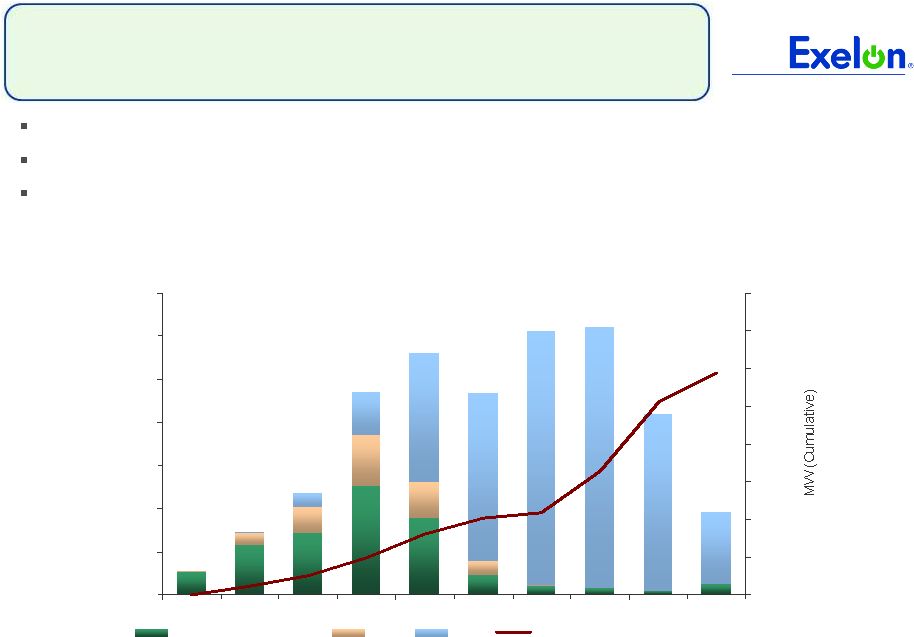  13
Nuclear uprates remain flexible to address changing
circumstances in power markets or regulation
Exelon's Uprate Plan Expenditures
(1)
$0
$100
$200
$300
$400
$500
$600
$700
2008A
2009A
2010A
2011E
2012E
2013E
2014E
2015E
2016E
2017E
0
200
400
600
800
1,000
1,200
1,400
1,600
Megawatt Recovery
MUR
EPU
MW Online (Cumulative)
$150
$250
$475
$550
$475
$600
$625
$425
$200
$ millions
Uprates are unique in that they can be suspended or delayed if economics are no
longer attractive 2011 spend is largely for turbine replacement, which we
expect will continue as planned Future spend will continue to be evaluated to
ensure the projects still meet economic return hurdles, but no uprate
projects have been cancelled at this time $50
(1) Dollars shown are nominal, reflecting 6% escalation, in millions and exclude TMI and Clinton
extended power uprates, which are currently under review. MW shown at ownership. Note:
MUR = measurement uncertainty recapture; EPU = extended power uprate. Data contained in this slide is rounded. |
